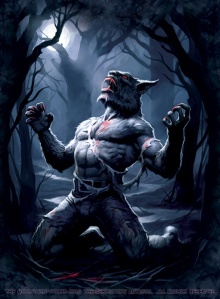Blog Archives
Folklore Tidbits – Werewolves Part 1
In folklore a werewolf is a mythological creature that can shape shift into the human form, this is usually caused by various types of curses and incantations, or a bite from another werewolf. The term werewolf is a huge widespread concept in European folklore ranging from early 15th century right up into the late 16th and17th century. Actually dying out in the late 18th century.
The persecution of these mythical beings became an integral part of witch hunts all over the world. A very famous Lycanthropy (which means Werewolfism) case took place in Jurgensburg Livonia in 1692, this township was inhabited by mostly Finnish and Baltic people. As the story goes an eighty year old peasant man known as Thiess was accused of being a werewolf, he claimed that he and some other unnamed clan had to go into hell three times a year to fight off the witches and Satan, this would have been at Pentecost ,St Lucia’s day and St Johns day.
At his trial Thiess refused to confess of witchcraft and consorting with the devil, stating that he had nothing to be ashamed of as there were many men who were fighting against the witches in werewolf form and that they were only there to help to secure a good harvest for the land. The judges were exasperated and did not know what to make of his strange story, and so decided to spare him ,and so instead he was given 10 lashes which was known back then as a flogging. It was noted in the trial of Thiess that he had a broken nose, he stated that he had received this wound whilst in battle with Skeistan who was another villager thought to be dabbling in Satanism, it was noted that he was actually presumed dead at the time of the trial.A German woodcut of a werewolf from 1722.Thiess claimed to be a werewolf, although asserted that in doing so he served God rather than the Devil, in contrast to common werewolf beliefs of the time.

A German woodcut of a werewolf from 1722.Thiess claimed to be a werewolf, although asserted that in doing so he served God rather than the Devil, in contrast to common werewolf beliefs of the time.
Theiss would have been considered a certain type of Werewolf that was known as the Benandanti, in translation this means [ the good walkers ]. The reason was that the witches would take the good grain down into the underground depths to prevent growth and cause the starvation of the lands. These werewolves were sent to fight back and to reclaim the grain that was taken and prevent further tragedy from happening with the livestock and the fish in their rivers. This Battle ensured a good harvest for the surrounding communities. The Benandanti unfortunately were often tried as witches. The belief was that they were connected to Satanism by uninformed peasant folk and the Church.
Legend states that The Benandanti wolves could travel out of their bodies. These spirits travelled within a form of sleep paralysis as they travelled out of their bodies around the countryside, they would struggle against malevolent witches to secure good crops for the season. They fought with iron bars whilst the witches used broom handles covered in horse tails.
The Benandanti were born with a caul on their heads, which is a piece of membrane that would cover their face and heads, it was also known as helmet head, this membrane was painlessly removed at birth mostly by a midwife. This phenomenon only happened in 1 in 80,000 births. It was believed that when a person was born this way, they had special abilities such as nocturnal visionary powers. the also had the ability in where the spirit could ride around the country on various animals, much like the Seelie and Unseelie folk from the fairy realms. This was how they would battle the malevolent forces that threatened their communities and crops.
Another interesting myth about werewolves deals with what is known as a Wolf Bann, A Wolf Bann, was a magical malevolent spell that could incite a wolf attack. It was a very popular term in German speaking Europe. The wolf of Ansbach is one such famous tale about a Wolf Bann, dating back from 1685. The citizens of Ansbach believed that a man eating wolf that had originally preyed on livestock, had resorted to preying on women and children to satisfy it’s hunger, was an incarnation of their evil mayor called “the German Bergmeister”. The mayor supposedly had a Wolf Bann placed upon him because of his tyrannies, and attack the town in retribution. It was recorded that during an organised hunt, that the the wolf was captured and slain and taken to the town where it was paraded in the market place dressed as the former mayor complete with a wig. It’s muzzle was then cut off and it was trussed up and shown off to all the townspeople to show they need not fear this great beast anymore, afterwards it went for preservation to the local museum.
For some more interesting reading on Werewolves and Werewolf Myths, I have added a few books that you should enjoy.
 The Werewolf Book by Brad Steiger
The Werewolf Book by Brad Steiger
 Werewolf Literature by Brian J Frost
Werewolf Literature by Brian J Frost
Next week we will continue with more on werewolves here on
Karen





